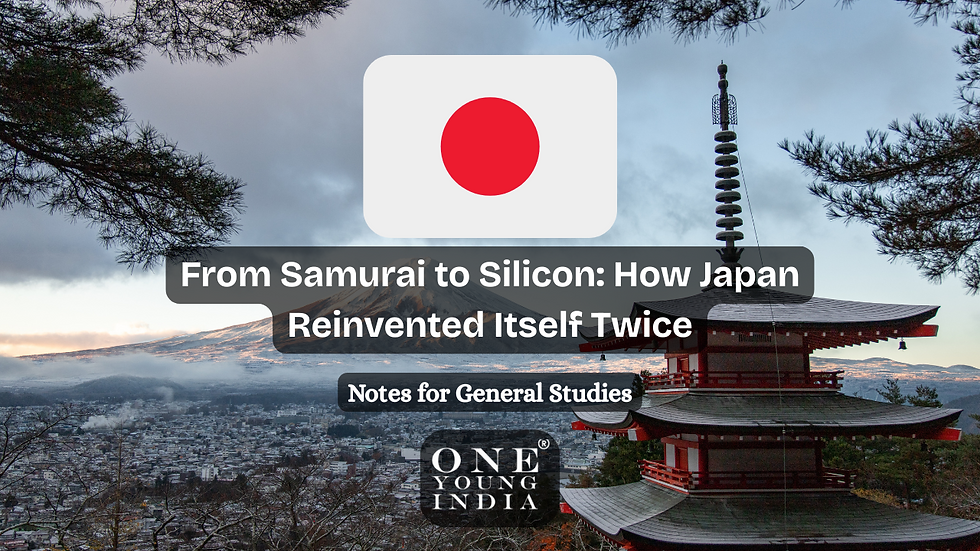From Samurai to Silicon: How Japan Reinvented Itself Twice
- One Young India

- Sep 20
- 4 min read
Introduction: The Land of Endless Reinvention
Few nations in history have shown the resilience, adaptability, and sheer determination that Japan has displayed. Twice in its history, Japan faced crises that could have shattered its existence—but instead, it emerged stronger and more influential than before. From the collapse of its feudal order in the 19th century to the devastation of World War II in the 20th, Japan reinvented itself with breathtaking speed. Today, its journey from samurai to silicon stands as one of the greatest stories of national transformation.

This blog explores how Japan reinvented itself not once but twice, first during the Meiji Restoration and later during its post-war economic miracle. By examining these two turning points, we uncover lessons about resilience, modernization, and the power of cultural adaptation.
The Age of the Samurai: A Feudal Foundation
For centuries, Japan existed as a land ruled by the samurai, bound by loyalty, honor, and rigid hierarchy. The Tokugawa Shogunate (1603–1868) established peace after centuries of war but also enforced strict isolation from the outside world, a policy known as sakoku. This isolation preserved Japanese traditions but left the nation technologically stagnant compared to rapidly industrializing Europe.
The samurai, once feared warriors, had transformed into bureaucrats and administrators. While their code of honor (bushidō) instilled discipline, it also tied Japan to outdated feudal systems. By the mid-19th century, Japan’s survival depended on whether it could move beyond this era.
The Shock of the Black Ships
In 1853, American Commodore Matthew Perry sailed into Edo Bay with a fleet of "Black Ships," demanding Japan open its ports to trade. This moment shook the nation to its core. For the first time, Japan realized that isolation left it vulnerable to foreign domination.
The arrival of Western powers exposed the cracks in the shogunate’s authority. Unequal treaties imposed by foreign nations humiliated Japan and sparked widespread unrest. For many leaders, it became clear: to protect Japan’s sovereignty, the nation needed to reinvent itself.
The Meiji Restoration: First Reinvention
Ending Feudalism
In 1868, the Tokugawa Shogunate collapsed, and power was restored to the emperor in what became known as the Meiji Restoration. The feudal domains were abolished, and the samurai class lost their privileged status. Japan dismantled centuries of tradition almost overnight, replacing them with a centralized government determined to modernize.
Westernization with Japanese Spirit
Japan sent missions abroad, studied Western legal systems, industries, and military structures, and brought back what worked. Yet, rather than blindly copying, Japan adapted Western ideas to suit its cultural context. The slogan “Japanese spirit, Western technology” captured the essence of this transformation.
Military and Industrial Transformation
The samurai sword gave way to modern rifles and battleships. Railways, telegraphs, and factories sprouted across the country. In just a few decades, Japan went from a feudal backwater to a modern industrial state capable of defeating major powers like China (1895) and Russia (1905).
This was the first time Japan reinvented itself—from a land of samurai to a modern nation-state.
The Path to Empire and Disaster
Japan’s rapid modernization also bred ambition. Eager to prove itself, Japan pursued imperial expansion in Korea, China, and Southeast Asia. While initially successful, this path eventually led to conflict with Western powers.
World War II proved catastrophic. Japan’s empire crumbled after the atomic bombings of Hiroshima and Nagasaki in 1945. Cities were reduced to rubble, the economy lay in ruins, and millions faced starvation. Japan had to start over once more.
Post-War Japan: The Second Reinvention
A Nation in Ashes
In 1945, Japan was devastated. Its cities were destroyed, industries dismantled, and morale shattered. Yet, from these ashes, Japan embarked on its second reinvention, transforming itself into an economic powerhouse.
American Occupation and Reforms
Under U.S. occupation, Japan adopted democratic reforms, land redistribution, and a pacifist constitution. The emperor was stripped of divine status, and women gained the right to vote. These reforms created the foundation for a modern society, but it was Japan’s cultural determination that fueled its comeback.
The Economic Miracle
From the 1950s to the 1980s, Japan experienced unprecedented economic growth. With an emphasis on education, efficiency, and innovation, Japan became synonymous with quality manufacturing. Companies like Toyota, Sony, and Panasonic led a global wave of technological excellence.
Japan didn’t just rebuild—it reinvented itself as the Silicon Valley of Asia, leading in electronics, automobiles, and robotics. The world now looked to Japan not as a defeated nation but as a leader in modern innovation.
Key Factors Behind Japan’s Double Reinvention
Cultural Resilience
Japan’s strong sense of identity allowed it to adapt foreign ideas without losing its own traditions. Whether adopting Western industry or American reforms, Japan always reshaped them to fit Japanese values.
Education and Discipline
Both reinventions placed education at the center. From samurai literacy to post-war universal schooling, Japan emphasized knowledge, discipline, and collective responsibility.
Government and Business Cooperation
During both the Meiji era and the post-war boom, Japan’s government played a guiding role. Strategic planning, industrial policy, and collaboration with businesses accelerated progress.
Lessons the World Can Learn
Japan’s story of reinvention offers universal lessons:
Adapt without losing identity. Japan modernized but preserved its traditions.
Crisis can be a catalyst. Both reinventions were born out of existential threats.
Invest in people. Education and discipline created the human capital that powered transformation.
Collaboration matters. Government, business, and society worked together toward shared goals.
Japan in the 21st Century: A New Challenge
Today, Japan faces fresh challenges: an aging population, economic stagnation, and competition from rising powers like China and South Korea. Yet, history suggests Japan may be preparing for a third reinvention.
Advancements in robotics, green technology, and artificial intelligence could once again place Japan at the forefront of global innovation. Just as it transformed from samurai to silicon, Japan may reinvent itself in ways the world has yet to imagine.
Conclusion: From Samurai to Silicon—and Beyond
Japan’s journey is nothing short of extraordinary. Twice in modern history, Japan reinvented itself in response to crisis—first by shedding feudalism during the Meiji Restoration, and later by rising from the devastation of World War II to become a technological leader.
The phrase “Japan reinvented itself” captures not just historical fact but a cultural truth: Japan has an unmatched ability to adapt, transform, and thrive. For other nations facing crisis, Japan’s story is a reminder that reinvention is possible with vision, resilience, and unity.



